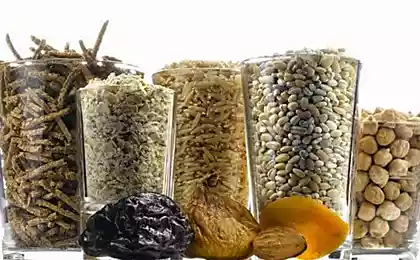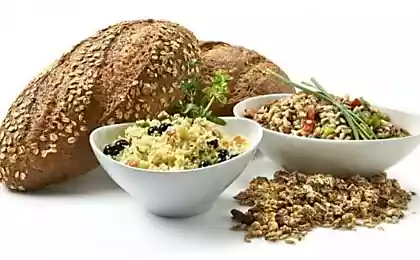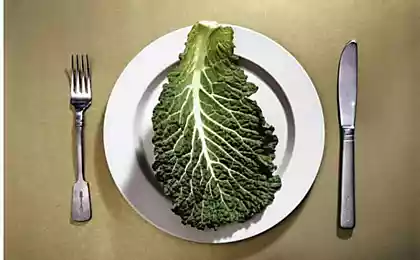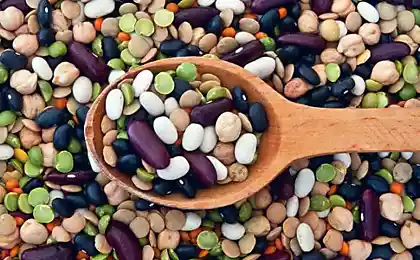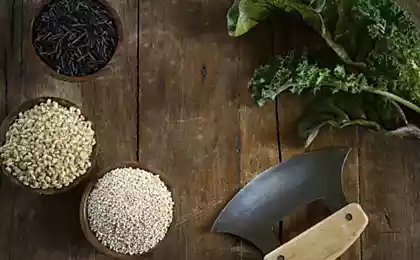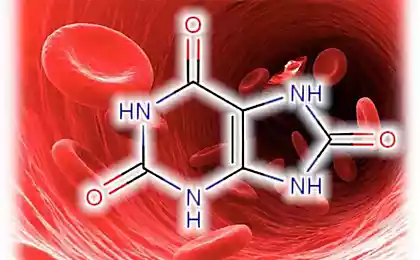643
Phytic acid in food: how to keep it at an acceptable level
Phytase is an enzyme that neutralizes phytic acid and liberates the phosphorus. Phytase in varying degrees co-exist in plants that contain phytic acid. Ruminants (cows, sheep, goats) have no problems with phytic acid due to phytase, which produce the microorganisms living in the rumen, the first of the four divisions of the stomach of ruminants.
Herbivores with a single stomach also produce fitzu, but in much smaller amounts. Mouse produce 30 times more phytase than humans, so they get away with lap diet some cereals. But you will never get away! And therefore, the results of experiments with phytic acid in mice is not applicable to man.
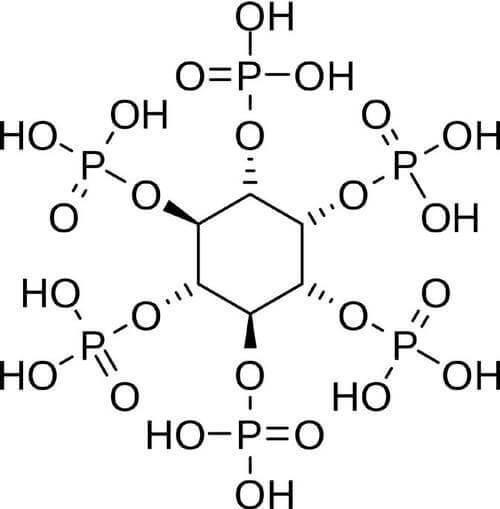
phytic acid the Purpose of this article is not to get afraid of products containing phytic acid, and to awaken caution and awareness of grains, legumes, nuts and seeds in our diet. No need to get rid of phytic acid, just enough to keep it at an acceptable level. 9000 years ago, or about 7000 years BC, humans began to cultivate wheat and barley, and 2500 years later in the year 4500 ad, corn and rice. Judging by the fossil remains of a man, a long time ago tooth decay was virtually nonexistent. Teeth found in Pakistan and approximately related to the year 5500 BC, bear evidence of drilling, apparently in connection with caries. The increasing incidence of tooth decay is also visible on the example of the indigenous people of America who have moved from the lifestyle of hunter-gatherers to food, where the leading role was to play the corn. Cultivation of crops gave rise to the evolution of civilizations, such as the one that appeared in Ancient Egypt, and the emergence of cities in which large groups of people lived together. Grains also made it possible to create large armies as it resolved the organizational problem of nutrition of thousands of soldiers.
Historically people knew about phytase (though in a different form) and never ate grains and legumes whole! Our ancestors and all uncivilized peoples soaked or fermented grains before cooking porridge, breads, cakes and grain dishes. One look at the recipes of the peoples of the world, it is sufficient to confirm this view. Interestingly, until the advent of industrial agriculture, farmers typically soaked crushed grain in hot water before feeding it to poultry and pigs. Today, manufacturers of agricultural feed added to the grain mixture to fitzu that promotes better growth of the animals. Surprisingly, for a man don't do that!
In India rice and lentils are fermented for at least 2 days before made idli and dosas. In Africa the locals soaked overnight roughly grind the corn before adding it to soups and broths, but they also fermented corn and millet for several days to make the porridge called orgi. A similar dish but made from oats, were traditionally among the natives of Wales. In some Oriental and Latin American countries it is customary for a long time to ferment the rice before cooking.
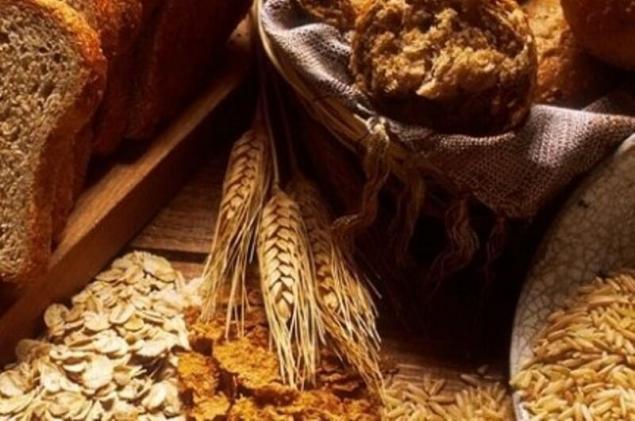
Ethiopians prepare your outstanding bread injera, within a few days of fermenting grain called Teff. Mexican corn cakes, called pozol, are fermented in banana leaves, and sometimes within two weeks. Before the invention of quick yeast Europeans made their own bread fermented sourdough. The first settlers of America were famous for their bread, pancakes and cakes leavened. And finally, throughout Europe grains were pre-soaked overnight and sometimes for several days in water or soured milk before you cook them porridge, or porridge, gruel. (Many older people will remember that before the packaging of cereal has been written about pre-soaking overnight).
Residents of the Swiss Alps did not use the whole rye grain. As in many other cultures of the world, the indigenous people of Switzerland began to process whole grain rye. However, after the slow grinding stone mill they sifted the corn, removing about 1/4 of the total weight of flour obtained in the form of impurities. Even without scientific knowledge about phytic acid and lecting the Swiss removed the phytic acid by using fermentation, and toxic lectins by sieving and, consequently, the mechanical separation of the germ and bran. The inhabitants of the mountainous Alps, cooked rye bread in large chunks and knead the dough by hand for four and a half hours. Typically, the people of the valley, Recently baked bread once a month, but they also existed an ancient recipe in which bread was prepared by the efforts of the whole community once a year. This means that all the rest of the year the grain was maturing. There is evidence that aging grains under certain conditions removes phytic acid and can also cause further collapse of other grain toxins.
Many recipes Japanese and Chinese cuisines to mention the already fermenting sprouted grains and especially legumes. Ie first bean sprouted, then fermented, and then (maybe!) will be welded.
Features of processing of grain from traditional peoples:
It makes no sense to make assumptions that intuitive feeling forced our ancestors to soak and ferment grains before you eat them. More importantly, this ancient technique is in good agreement with that opened the modern science of cereal lately. Neutralized phytic acid can connect in the intestines with calcium, magnesium, copper, iron and especially zinc and thus prevent their absorption.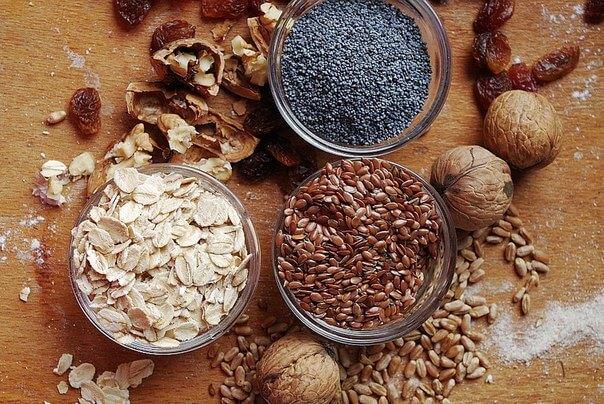
That's why a diet that includes the consumption of unfermented whole grains may lead to serious mineral deficiencies and bone loss. Fashionable and it is bad practice to consume large quantities of unprocessed bran often initially improves digestion and relieves constipation, but later can lead to irritable bowel syndrome and, in a longer time, other undesirable effects. Soaking allows enzymes, lactobacilli and other friendly organisms to break down and neutralize phytic acid. Only 7 hours of soaking in warm, slightly acidic environment allows you to neutralize the main part of the phytic acid in grains. Simple soaking of milled cereals and cereal at night greatly improves their nutritional value.
And though the digestive tract of man does not produce enough phytase to safely consume large quantities of food with high content of phytic acid on a regular basis, lactic acid bacteria lactobacilli and other microorganisms of the endogenous digestive microflora can produce picazo. In other words, people with a healthy intestinal flora is easier to cope with food containing phytic acid.
Picazo in plants stimulates germination, thereby reducing the amount of phytic acid. Also fitzu activates soaking grains and flour in an acidic and warm environment, as in the manufacture of sourdough.
But not all grains contain picazo in an amount sufficient to eliminate phytic acid. For example, the phytase in corn, millet, oats and brown rice are not enough to neutralize the phytic acid, even in case of proper preparation. On the other hand, wheat and rye are high levels of phytase — wheat contains 4 times more phytase than brown rice, and rye almost 2 times more than wheat. Soaking or souring these grains in warm acidic environment completely removes the phytic acid. High levels of phytic acid in rye is one of the reasons why rye flour is preferable to bread yeast.
Phytase is destroyed at 80°C in less than 10 minutes. In humid conditions, phytase is destroyed at 55-65°C. In some sources say that 40 degrees is enough to ruin picazo.
Thermal processing such as extrusion, completely destroys picazo. Therefore, extrusion whole-grain breads and granola is a sure way to get digestive problems and mineral deficiencies.
Phytase is present in small amounts in oats, but heat in the production of commercial cereals leads her to an inactive state. Picazo destroys even the grinding of grain at too high speeds and high temperatures, and freezing and prolonged storage. Fresh flour contains more phytase than the one that was stored for several months. In traditional cultures it is customary to grind the grain right before brewing.
Phytic threshold
It seems that as soon as the level of phytic acid reduces bioavailability of phosphorus becomes higher than in the bound state, the critical point is passed and the food becomes more beneficial than harmful. I.e. as soon as the level of Filatov will be no more than 30-40% of the total phosphorus, the food becomes more beneficial than harmful.
Ideally, the amount of phytic acid should not be above 25 mg per 100 g, or about 0.03% in the diet containing phytic acid. And even white rice and white bread are foods with a low content of phytic acid, they are also devoid of vitamins and minerals contained in a remote shell and germ of the grain. However, the low number of antinutrients in them explains why in one families those who eat refined flour and white rice, are relatively healthy, while eating brown rice and bread with bran suffer from tooth decay, loss of inert mass and other diseases.
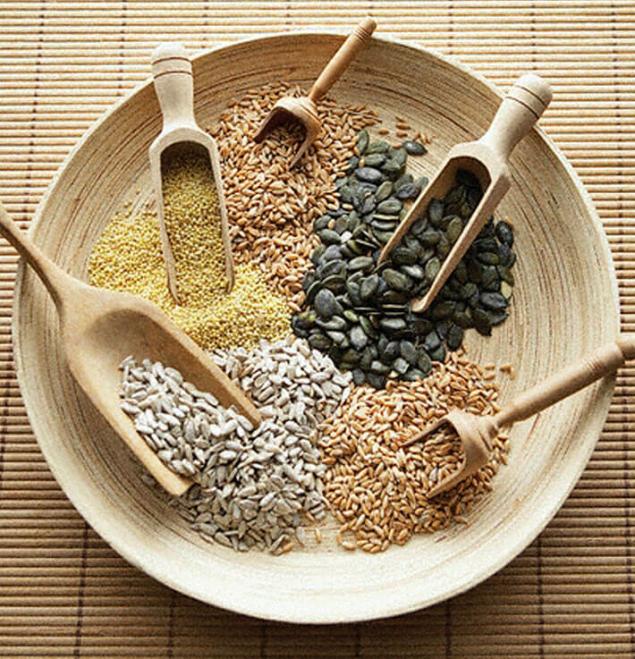
Exceeding the daily limit of 800 mg phytic acid is probably not the best idea. The average content of phytic acid in standard American and British diet is 631 and 764 mg, respectively; the average in Finland is 370 mg, Italy — 21, in Sweden only 180.
From a practical point of view, this means that to eliminate at least part of the phytic acid from our diet makes sense to properly prepare grains, legumes and nuts, and to limit the number to 2-3 servings per day. Also interesting: the survivorship bias and the error is recovered Phytic acid: breads
Daily consumption of a piece of whole wheat bread, handful of soaked nuts and a serving of properly cooked cereals, pancakes or beans does not endanger our health. The problem comes in when cereals and legumes constitute the principal source of calories when every meal includes more than one whole grain product and when a large part of the diet are nuts and legumes. Unfermented soy products, ekstrudirovannyj cereals, granola, muesli, air biscuits and other foods rich in phytic acid, should be avoided.published Author: Andrey Blueskin
Source: www.beloveshkin.com/2015/02/2.html
Herbivores with a single stomach also produce fitzu, but in much smaller amounts. Mouse produce 30 times more phytase than humans, so they get away with lap diet some cereals. But you will never get away! And therefore, the results of experiments with phytic acid in mice is not applicable to man.

phytic acid the Purpose of this article is not to get afraid of products containing phytic acid, and to awaken caution and awareness of grains, legumes, nuts and seeds in our diet. No need to get rid of phytic acid, just enough to keep it at an acceptable level. 9000 years ago, or about 7000 years BC, humans began to cultivate wheat and barley, and 2500 years later in the year 4500 ad, corn and rice. Judging by the fossil remains of a man, a long time ago tooth decay was virtually nonexistent. Teeth found in Pakistan and approximately related to the year 5500 BC, bear evidence of drilling, apparently in connection with caries. The increasing incidence of tooth decay is also visible on the example of the indigenous people of America who have moved from the lifestyle of hunter-gatherers to food, where the leading role was to play the corn. Cultivation of crops gave rise to the evolution of civilizations, such as the one that appeared in Ancient Egypt, and the emergence of cities in which large groups of people lived together. Grains also made it possible to create large armies as it resolved the organizational problem of nutrition of thousands of soldiers.
Historically people knew about phytase (though in a different form) and never ate grains and legumes whole! Our ancestors and all uncivilized peoples soaked or fermented grains before cooking porridge, breads, cakes and grain dishes. One look at the recipes of the peoples of the world, it is sufficient to confirm this view. Interestingly, until the advent of industrial agriculture, farmers typically soaked crushed grain in hot water before feeding it to poultry and pigs. Today, manufacturers of agricultural feed added to the grain mixture to fitzu that promotes better growth of the animals. Surprisingly, for a man don't do that!
In India rice and lentils are fermented for at least 2 days before made idli and dosas. In Africa the locals soaked overnight roughly grind the corn before adding it to soups and broths, but they also fermented corn and millet for several days to make the porridge called orgi. A similar dish but made from oats, were traditionally among the natives of Wales. In some Oriental and Latin American countries it is customary for a long time to ferment the rice before cooking.

Ethiopians prepare your outstanding bread injera, within a few days of fermenting grain called Teff. Mexican corn cakes, called pozol, are fermented in banana leaves, and sometimes within two weeks. Before the invention of quick yeast Europeans made their own bread fermented sourdough. The first settlers of America were famous for their bread, pancakes and cakes leavened. And finally, throughout Europe grains were pre-soaked overnight and sometimes for several days in water or soured milk before you cook them porridge, or porridge, gruel. (Many older people will remember that before the packaging of cereal has been written about pre-soaking overnight).
Residents of the Swiss Alps did not use the whole rye grain. As in many other cultures of the world, the indigenous people of Switzerland began to process whole grain rye. However, after the slow grinding stone mill they sifted the corn, removing about 1/4 of the total weight of flour obtained in the form of impurities. Even without scientific knowledge about phytic acid and lecting the Swiss removed the phytic acid by using fermentation, and toxic lectins by sieving and, consequently, the mechanical separation of the germ and bran. The inhabitants of the mountainous Alps, cooked rye bread in large chunks and knead the dough by hand for four and a half hours. Typically, the people of the valley, Recently baked bread once a month, but they also existed an ancient recipe in which bread was prepared by the efforts of the whole community once a year. This means that all the rest of the year the grain was maturing. There is evidence that aging grains under certain conditions removes phytic acid and can also cause further collapse of other grain toxins.
Many recipes Japanese and Chinese cuisines to mention the already fermenting sprouted grains and especially legumes. Ie first bean sprouted, then fermented, and then (maybe!) will be welded.
Features of processing of grain from traditional peoples:
- Biodynamic farming.
- Careful methods of harvesting grain, including slow drying in the sun.
- The aging of grain.
- Thorough methods of storing grain, often together with the outer shell to preserve freshness.
- Grinding grain before cooking.
- The combination of grain with other products.
- Often the removal of bran and germ.
- The use of sourdough and grain, which contain enough phytase.
It makes no sense to make assumptions that intuitive feeling forced our ancestors to soak and ferment grains before you eat them. More importantly, this ancient technique is in good agreement with that opened the modern science of cereal lately. Neutralized phytic acid can connect in the intestines with calcium, magnesium, copper, iron and especially zinc and thus prevent their absorption.

That's why a diet that includes the consumption of unfermented whole grains may lead to serious mineral deficiencies and bone loss. Fashionable and it is bad practice to consume large quantities of unprocessed bran often initially improves digestion and relieves constipation, but later can lead to irritable bowel syndrome and, in a longer time, other undesirable effects. Soaking allows enzymes, lactobacilli and other friendly organisms to break down and neutralize phytic acid. Only 7 hours of soaking in warm, slightly acidic environment allows you to neutralize the main part of the phytic acid in grains. Simple soaking of milled cereals and cereal at night greatly improves their nutritional value.
And though the digestive tract of man does not produce enough phytase to safely consume large quantities of food with high content of phytic acid on a regular basis, lactic acid bacteria lactobacilli and other microorganisms of the endogenous digestive microflora can produce picazo. In other words, people with a healthy intestinal flora is easier to cope with food containing phytic acid.
Picazo in plants stimulates germination, thereby reducing the amount of phytic acid. Also fitzu activates soaking grains and flour in an acidic and warm environment, as in the manufacture of sourdough.
But not all grains contain picazo in an amount sufficient to eliminate phytic acid. For example, the phytase in corn, millet, oats and brown rice are not enough to neutralize the phytic acid, even in case of proper preparation. On the other hand, wheat and rye are high levels of phytase — wheat contains 4 times more phytase than brown rice, and rye almost 2 times more than wheat. Soaking or souring these grains in warm acidic environment completely removes the phytic acid. High levels of phytic acid in rye is one of the reasons why rye flour is preferable to bread yeast.
Phytase is destroyed at 80°C in less than 10 minutes. In humid conditions, phytase is destroyed at 55-65°C. In some sources say that 40 degrees is enough to ruin picazo.
Thermal processing such as extrusion, completely destroys picazo. Therefore, extrusion whole-grain breads and granola is a sure way to get digestive problems and mineral deficiencies.
Phytase is present in small amounts in oats, but heat in the production of commercial cereals leads her to an inactive state. Picazo destroys even the grinding of grain at too high speeds and high temperatures, and freezing and prolonged storage. Fresh flour contains more phytase than the one that was stored for several months. In traditional cultures it is customary to grind the grain right before brewing.
Phytic threshold
It seems that as soon as the level of phytic acid reduces bioavailability of phosphorus becomes higher than in the bound state, the critical point is passed and the food becomes more beneficial than harmful. I.e. as soon as the level of Filatov will be no more than 30-40% of the total phosphorus, the food becomes more beneficial than harmful.
Ideally, the amount of phytic acid should not be above 25 mg per 100 g, or about 0.03% in the diet containing phytic acid. And even white rice and white bread are foods with a low content of phytic acid, they are also devoid of vitamins and minerals contained in a remote shell and germ of the grain. However, the low number of antinutrients in them explains why in one families those who eat refined flour and white rice, are relatively healthy, while eating brown rice and bread with bran suffer from tooth decay, loss of inert mass and other diseases.

Exceeding the daily limit of 800 mg phytic acid is probably not the best idea. The average content of phytic acid in standard American and British diet is 631 and 764 mg, respectively; the average in Finland is 370 mg, Italy — 21, in Sweden only 180.
- In the context of a diet rich in calcium, vitamins D, A and C, quality fats and lacto-fermented vegetables (such as sauerkraut, tomatoes and cucumbers), most will feel perfectly at 400-800 mg of phytic acid per day.
- For those who suffer from tooth decay, bone loss or mineral deficiencies, recommended the use of phytic acid at the level of 150-400 mg/day.
- For children under 6 years, pregnant women and seriously ill it is best to keep the amount of phytic acid as low as possible.
From a practical point of view, this means that to eliminate at least part of the phytic acid from our diet makes sense to properly prepare grains, legumes and nuts, and to limit the number to 2-3 servings per day. Also interesting: the survivorship bias and the error is recovered Phytic acid: breads
Daily consumption of a piece of whole wheat bread, handful of soaked nuts and a serving of properly cooked cereals, pancakes or beans does not endanger our health. The problem comes in when cereals and legumes constitute the principal source of calories when every meal includes more than one whole grain product and when a large part of the diet are nuts and legumes. Unfermented soy products, ekstrudirovannyj cereals, granola, muesli, air biscuits and other foods rich in phytic acid, should be avoided.published Author: Andrey Blueskin
Source: www.beloveshkin.com/2015/02/2.html
The garden of Igor Liadov – the miracle, it is feasible to everyone
General Motors begins production of 200-mile Chevrolet Bolt
